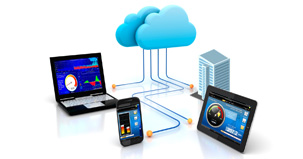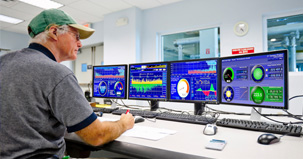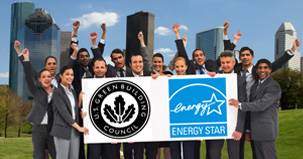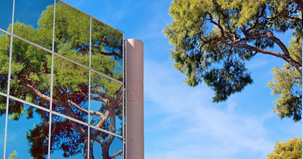- Home
- Smart Data
Smart Data
Actionable intelligence on energy and water use:
- Helps users identify inefficencies, and waste
- Provides real-time feedback on conservation
Right data for the right audience:
- Facility managers identify when and where energy is wasted
- CFO's can track and verify financial savings from initiatives
- Company knows its carbon and water footprint
Related Products
 Information any time, anywhere
Information any time, anywhere - Smart User
Smart User
Smart users leverage real-time data and reduce energy and water use by:
- Continuously identifying opportunities
- Acting on opportunities
- Tracking and verifying savings
- Sustaining savings
Related Products
 Monitor, Manage, Maintain
Monitor, Manage, Maintain - Smart Community
Smart Community
A smart community is one where all stakeholders are engaged in energy and water conservation. A smart community can be achieved by:
- Showing people precisely how much they are using
- Providing real-time feedback on conservation actions
- Effectively communicating efficiency results
Related Products
 Communicate and Conserve
Communicate and Conserve - Smart Grid
Smart Grid
Smart grid, as we define it, is a "green grid", with efficient resource use and the key to a low-carbon future. We help our customers prepare for the smart grid by:
- Engaging users with smart data
- Enabling smart users to increase resource efficiency
- Educating & empowering smart communities
Related Products
 Smart grid and a smarter future
Smart grid and a smarter future - Smart Buildings
Smart Buildings
Smart buildings maximize resource (energy, water, capital) efficiency. These buildings are optimized using energy and water management process with high data visibility which lead to reduced energy and water spending.
- Higher operating income and higher asset values for owners
- Increased productivity for occupants
- Lower carbon footprint for the community
 Resource efficient buildings
Resource efficient buildings
Recent Posts
Sustainability: Progress in Packaging
There isn’t a product that hits shelves whose packaging hasn’t been designed – and redesigned – by the sales and marketing folks who believe they know exactly what consumers look for and will choose among the sea of options on store shelves or web pages. And then, of course, the safety and loss prevention people get their say – before the packaging gets finalized.
Enter the latest voice from the packaging peanut gallery: sustainability. It’s not really a surprise that business has been wary about modifying packaging to reduce environmental impacts. Any changes – even the smallest ones to already recognized packaging – could make the difference between a sale and no sale.
That being said, there has been significant progress, even in the luxury segment of the market, where packaging is the brand and in itself the packaging is an $11.9 billion business annually.
“Sustainability,” when applied to packaging, covers a large number of functions. Just some of those are the design of the container, raw materials used, energy and water consumed in production, resources needed for transportation, waste produced, impacts on workers, and what is written on the label. Changes in any one or more of these usually entail strategic decisions about procurement, supply chain management, production, shipping, disposal, human resources, and labeling. Costs have to be factored in and regulatory approval can take up to two years. But, pressure from consumers, media, investors, global, national, and state government bodies, and activists has created a revolution in how products are packaged. And, that’s only in its early stages. Overall, packaging has been a laggard in the environmentalism.
Now, Wal-Mart, Unilever, McDonald’s, and MillerCoors are among the growing number of companies that publish their own detailed information and communicate with the media about their efforts in packaging sustainability. For example, Wal-Mart announced its goal of reducing global packaging by five percent by 2013.
Much of the focus of global companies has been on gaining commitment from their supply chain for these initiatives. That extends from sourcing of materials, especially scarce, hazardous, and fossil-fuel ones, to what the label, which more consumers analyze, can legally and ethically state.In the high-margin luxury niche, making packaging more eco-friendly had been a topic at the 2011 global Luxe Pack conference. The challenge was framed as maintaining the brand differentiation from private label products through unique packaging but doing that in ways that minimize environmental impacts. There are also new labeling requirements for luxury products to combat the practice of stating that the container is “green,” without providing documentation of that. Months before the conference, cosmetic leader L’Oreal issued its own assessment system to track packaging sustainability and committed to using the Sustainable Packaging Alliance’s Packaging Impact Quick Evaluation Tool (PIQET).
The biggest gains are expected in developing economies. There, a middle class is growing which is brand conscious including about luxury products. The Asia Pacific region, for example, has a 35 percent market share for worldwide luxury sales. Also the businesses in emerging nations want to be perceived as a “good corporate citizens” in order to become vendors for a developed-economy. As a result, they are investing in packaging sustainability, even though the current costs may have no immediate return on investment.



